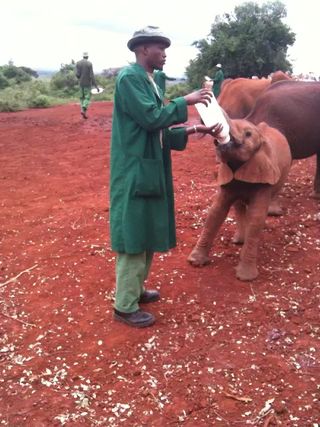Health
Why Justice for Animals Is the Social Movement of Our Time
Reflections from a human rights doctor (guest essay by Dr. Hope Ferdowsian)
Posted March 19, 2016
It is my pleasure to post this guest essay by Dr. Hope Ferdowsian. I hope you enjoy it as much as I have. I thank Lybi Ma for allowing me to share this essay with you.
Earlier this week, SeaWorld finally caved to public criticism and ended its orca (killer whale) breeding program. This will be the last generation of orcas held captive by SeaWorld. The announcement follows international efforts to acknowledge the rights of whales and dolphins.
News from SeaWorld came almost exactly one year after Ringling Brothers first publicly conceded that it would stop using elephants in circuses.
Both advancements show how more and more people believe that (nonhuman) animals fit within a framework of social justice. Growing concern for animals is reflected in the large number of books, magazine articles, and films about the plight of animals. Worldwide enthusiastic responses to documentaries like Blackfish, The Cove, Parrot Confidential, Project Nim, and Cowspiracy illustrate the high level of public interest in animal issues.
These trends are supported by public opinion surveys. Of six causes tracked in a 2014 Humane Research Council survey of 1,000 American adults, animal protection was ranked most favorably in importance, followed by environmental protection and civil liberties. The number of strong supporters for animal protection approximately doubled between 2005 and 2014.
A 2015 Gallup poll even showed that at least one-third of Americans believe “animals deserve the exact same rights as people to be free from harm and exploitation.”
Take a minute to think about the gravity of that assertion – and its potential implications. I count myself among the one-third of Americans who agree with the Gallup poll statement about animals.
As an internist, preventive medicine, and public health physician who works in human rights, I have spent the last decade trying to prevent human diseases and disorders before they occur, treating difficult health conditions, evaluating asylum seekers for indications of torture, caring for sexual violence survivors, and trying to dismantle social determinants of health. Before that, I spent four years in college, four years in medical school, one year as an intern working more than one hundred hours per week, and four years completing two residency programs. Today, all of my work as a doctor is driven by my quest for social justice.

You might be surprised that I believe that justice for animals is the social movement of our time. But, more than anything, I believe it. Here’s why. Like us, animals are deeply vulnerable beings. In fact, much of our own vulnerability stems from the fact that we are animals.

There is no longer dispute among serious scientists that humans aren’t the only animals who have the capacity to suffer physically and mentally. Elephants, great apes, orcas, dogs, cats, and many other animals can experience depression, posttraumatic stress disorder (PTSD), anxiety, and compulsive disorders. In a study first published in 2011, my colleagues and I showed how chimpanzees used in the biomedical and entertainment industries suffered from PTSD and other mental disorders – much like the psychiatric conditions I’ve documented in human torture survivors (please also see "Psychological Disorders in Animals: A Review of What We Know").
Suffering among other animals is no less than ours. It’s possible they suffer even more than many of us do, simply because of their inability to understand what is happening to them, make sense of their plight, escape from it, or alter their conditions (for more on this please see "Do "Smarter" Dogs Really Suffer More than "Dumber" Mice?").
Currently, all of our legal, economic, and cultural paradigms render animals even more vulnerable than they already are. Like many of the patients I have cared for, animals have no political power. But they are also considered property. They can be bought and sold – not unlike many of the girls and women around the world whom my colleagues and I advocate on behalf of.
Historically, as early as the nineteenth century, cruelty against vulnerable people – such as children – and animals were treated as a united cause. Members of the public recognized that violence against people and animals shared common origins, requiring similar solutions. Abuses against animals were seen as a slippery slope toward human abuses. Respecting animals was viewed as a critical first step toward justice and progress.
Today, however, the human and animal rights movements now miss an important opportunity by working in different silos. Fortunately, there is a growing modern movement that recognizes the link between violence against people and animals.
Some people worry about what would happen to humans if we were to take the lives of animals more seriously. But, fortunately, recognizing the needs of animals does not minimize who we are as people. On the contrary, future advancements for animals could help enlighten and benefit us, similar to how recognizing the rights of women and girls has also helped men and boys – as we have seen in the fight against sexual violence and in other areas of society.
While further progress needs to be made on behalf of vulnerable human populations, the rights of people and animals are not mutually exclusive. This is not a zero-sum game. On the contrary, there is common ground occupied by those working on behalf of people and animals – both because of the shared potential for suffering and because many solutions to successfully combat domination, violence, and abuse are universal.
At the heart of every human rights resolution is a conviction that we, as humans, should not be unjustly imprisoned or suffer torture and other trespasses. There is no sound reason this conviction shouldn’t also apply to animals like the orcas at SeaWorld or the Ringling Brothers elephants. Animals have qualities we find important to the legal rights of humans – like self-awareness, the need for sovereignty, and the capacity for suffering, love, and empathy. We will never fully dismantle the injustices humans suffer without deconstructing the same problems that lead to animal suffering.
Ultimately, we are left with the question of "How we will treat those who are most vulnerable to us – human and otherwise. How will we answer? And what if we don’t answer adequately or soon enough?"
As we’ve seen with SeaWorld, an impassioned public response can make all the difference in the world. The time is now for accepting that justice for animals is the social movement of our time and we all need to do something to make this a reality right now.




